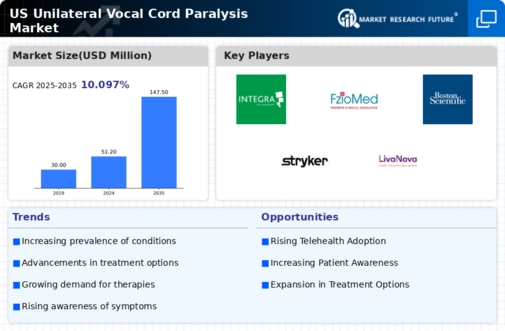Advancements in Surgical Techniques
Innovations in surgical techniques are significantly impacting the unilateral vocal-cord-paralysis market. Minimally invasive procedures, such as laryngeal framework surgery and injection laryngoplasty, have gained traction due to their effectiveness and reduced recovery times. These advancements not only enhance patient safety but also improve overall treatment outcomes. The market is projected to grow as more healthcare facilities adopt these modern techniques, which are often associated with lower complication rates. Furthermore, the increasing availability of specialized training for surgeons in these advanced methods is likely to contribute to the market's growth, as more practitioners become proficient in treating unilateral vocal cord paralysis.
Increased Focus on Patient-Centric Care
The unilateral vocal-cord-paralysis market is witnessing a shift towards patient-centric care models. Healthcare providers are increasingly prioritizing individualized treatment plans that cater to the specific needs of patients. This trend is driven by a growing recognition of the importance of patient satisfaction and quality of life in treatment outcomes. As a result, therapies that focus on restoring vocal function and improving communication abilities are gaining popularity. The emphasis on patient engagement and education is likely to enhance treatment adherence, which may positively impact the unilateral vocal-cord-paralysis market. Furthermore, this focus on personalized care is expected to foster innovation in treatment modalities, leading to the development of more effective therapies.
Rising Incidence of Vocal Cord Disorders
The unilateral vocal-cord-paralysis market is experiencing growth due to the increasing incidence of vocal cord disorders in the US. Factors such as aging populations and lifestyle-related health issues contribute to this rise. According to recent estimates, approximately 30,000 new cases of vocal cord paralysis are reported annually in the US. This growing patient population necessitates advanced treatment options, thereby driving demand within the unilateral vocal-cord-paralysis market. Healthcare providers are increasingly focusing on innovative therapies and surgical interventions to address these conditions, which may lead to improved patient outcomes. As awareness of vocal cord disorders increases, more individuals are seeking medical attention, further propelling the market's expansion.
Growing Investment in Healthcare Infrastructure
The unilateral vocal-cord-paralysis market is benefiting from increased investment in healthcare infrastructure across the US. Government initiatives aimed at enhancing healthcare facilities and services are creating a more conducive environment for the treatment of vocal cord disorders. This investment is expected to lead to improved access to specialized care, which is crucial for patients suffering from unilateral vocal cord paralysis. Additionally, the expansion of outpatient surgical centers and rehabilitation facilities is likely to facilitate timely interventions, thereby enhancing patient outcomes. As healthcare infrastructure continues to evolve, the unilateral vocal-cord-paralysis market is poised for growth, driven by better access to care and advanced treatment options.
Rising Demand for Non-Surgical Treatment Options
The unilateral vocal-cord-paralysis market is experiencing a notable shift towards non-surgical treatment options. Patients are increasingly seeking alternatives to invasive procedures, driven by concerns over recovery times and potential complications. Non-surgical interventions, such as voice therapy and injection laryngoplasty, are gaining traction due to their effectiveness and lower risk profiles. This trend is supported by a growing body of evidence highlighting the benefits of conservative management for vocal cord paralysis. As healthcare providers expand their offerings to include these non-invasive options, the unilateral vocal-cord-paralysis market is likely to see increased demand, reflecting a broader shift in patient preferences towards less invasive treatment modalities.
















Leave a Comment